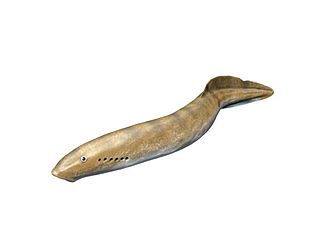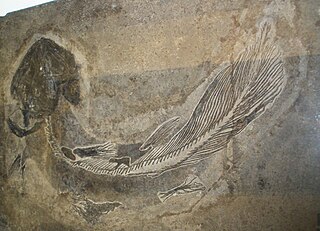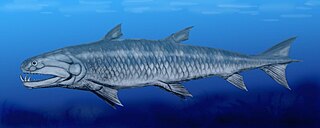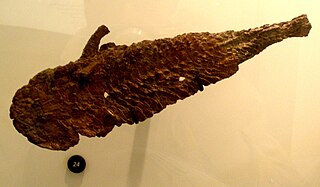
Sarcopterygii —sometimes considered synonymous with Crossopterygii —is a taxon of the bony fishes whose members are known as lobe-finned fishes. The group Tetrapoda, a superclass including amphibians, reptiles, and mammals, evolved from certain sarcopterygians; under a cladistic view, tetrapods are themselves considered a group within Sarcopterygii.

Hyperoartia or Petromyzontida is a disputed group of vertebrates that includes the modern lampreys and their fossil relatives. Examples of hyperoartians from early in their fossil record are Endeiolepis and Euphanerops, fish-like animals with hypocercal tails that lived during the Late Devonian Period. Some paleontologists still place these forms among the "ostracoderms" of the class Anaspida, but this is increasingly considered an artificial arrangement based on ancestral traits.

Eusthenopteron is a genus of prehistoric sarcopterygian which has attained an iconic status from its close relationships to tetrapods. The name derives from two Greek stems—eustheno- "strength" and -pteron "wing" and thus "strongly developed fins". Early depictions of this animal show it emerging onto land; however, paleontologists now widely agree that it was a strictly aquatic animal. The genus Eusthenopteron is known from several species that lived during the Late Devonian period, about 385 million years ago. Eusthenopteron was first described by J. F. Whiteaves in 1881, as part of a large collection of fishes from Miguasha, Quebec. Some 2,000 Eusthenopteron specimens have been collected from Miguasha, one of which was the object of intensely detailed study and several papers from the 1940s to the 1990s by paleoichthyologist Erik Jarvik.

Coelacanthus is a genus of extinct coelacanths that first appeared during the Permian period. It was the first genus of coelacanths described, about a century before the discovery of the extant coelacanth. The order Coelacanthiformes is named after it.

Ischnacanthus is an extinct genus of jawed fish in the class Acanthodii. It lived during the Early Devonian period, approximately 421–409 million years ago. It is known from a single species, which is also the type species, I. gracilis.

Onychodontiformes is an order of prehistoric sarcopterygian fish that lived between Late Silurian to Late Devonian period. A phylogenetic analysis of sarcopterygians, incorporating new fossils of Qingmenodus and neurocranial characters previously neglected, supported Onychodontiformes as stem-coelacanths within Actinistia.

Onychodus is a genus of prehistoric lobe-finned fish which lived during the Devonian period. It is one of the best known of the group of onychodontiform fishes. Scattered fossil bones of Onychodus were first discovered in 1857, in North America, and described by John Strong Newberry. Other species were found in Australia, England, Norway and Germany showing that it had a widespread range.
Bukkanodus jesseni is a species of prehistoric lobe-finned fish which lived during the Early Devonian period. B. jesseni was first described in 2007 by paleontologist Zerina Johanson in the Journal of Paleontology from specimens found in the Fairy Formation of Victoria, Australia.

Porolepiformes is an order of prehistoric lobe-finned fish which lived during the Devonian period. The group contains two families: Holoptychiidae and Porolepididae.

The Megalichthyidae are a family of prehistoric lobe-finned fishes which lived from the late Devonian to the early Permian period.

Glyptolepis is an extinct genus of porolepiform lobe-finned fish which lived during Devonian Period, from the early Eifelian to Frasnian Age.
Chrysolepis is a genus of prehistoric lobe-finned fish that lived during the Late Devonian period.

Heptanema is an extinct genus of prehistoric coelacanth from the Middle Triassic (Ladinian) of northern Italy.
Mioceratodus is an extinct genus of lungfish in the family Neoceratodontidae, which also contains the extant Queensland lungfish. It is known only from Oligocene and Miocene-aged sediments in Australia, although phylogenetic evidence supports it having first diverged from its closest relative, Neoceratodus, during the Late Jurassic or Early Cretaceous period.

Porolepis is an extinct genus of porolepiform sarcopterygian fish, from the Early Devonian Dniester Series of Ukraine, which is rich in Porolepis remains, and also the Nellen Koepfchen Beds of Germany. It lived alongside the dubious lophotrochozoan Macrodontophion. It was first described in 1858 but Porolepis was not named as a sufficient species until 1891.

Paraceratodus is an extinct genus of prehistoric lungfish. Only one species, P. germaini, is known from the latest Permian or earliest Triassic period of Madagascar. Phylogenetic evidence supports it being the most basal member of the suborder Ceratodontoidei, which contains modern lungfish, and as with the rest of the order it likely diverged during the late Carboniferous.
Orlovichthys is an extinct genus of prehistoric sarcopterygians or lobe-finned fish. Fossil evidence was found in Russia, and is from the Late Devonian period.

The evolution of fish began about 530 million years ago during the Cambrian explosion. It was during this time that the early chordates developed the skull and the vertebral column, leading to the first craniates and vertebrates. The first fish lineages belong to the Agnatha, or jawless fish. Early examples include Haikouichthys. During the late Cambrian, eel-like jawless fish called the conodonts, and small mostly armoured fish known as ostracoderms, first appeared. Most jawless fish are now extinct; but the extant lampreys may approximate ancient pre-jawed fish. Lampreys belong to the Cyclostomata, which includes the extant hagfish, and this group may have split early on from other agnathans.

Antarctaspis is an extinct genus of placoderm fish which existed in Antarctica during the Devonian period. It was first named by Louis Agassiz in 1845, and the type species, Antarctaspis mcmurdoensis by White in 1986. It is known from a partial head shield.
Euphaneropidae is an extinct family of prehistoric jawless fishes in the extinct order Euphanerida. These fishes are characterised by a greatly elongated branchial apparatus which covers most of the length of the body. Fossils are known from the Lower Silurian and Middle Devonian of Scotland, and the Upper Devonian of Canada. In particular, Euphanerops is unique in that it has two anal fins.


















